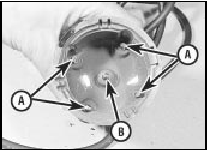Ignition system component check (Every 24 000 miles (40 000 km) or 2 years)
1 Before disturbing any part of the ignition system, disconnect the battery negative lead.
2 Identify and clearly mark all HT leads before disconnecting them from the spark plugs.
3 Refer to the appropriate Section in Chapter 5 and, where applicable, remove the distributor cap and rotor arm.
4 Clean the HT leads and distributor cap with a dry cloth. Scrape any corrosion or other deposits from the connectors and terminals.
Also clean the coil tower.
5 Renew the HT leads if they are cracked, burnt or otherwise damaged. If a multi-meter is available, measure the resistance of the leads. The desired value is given in the Specifications of Chapter 5.
6 Renew the distributor cap if it is cracked or badly burnt inside, or if there is evidence of “tracking” (black lines marking the path of HT leakage). If there is a carbon brush at the centre of the cap, make sure that it moves freely, and is not excessively worn (see illustration).

39.6 Bosch distributor cap showing HT segments (A) and carbon brush (B)
7 Clean the metal track of the rotor arm with fine abrasive paper. Renew the arm if it is cracked or badly burnt.
8 Refit the rotor arm and distributor cap.
9 Reconnect the HT leads to the spark plugs and coil.
10 Reconnect the battery and run the engine.
See also:
Front wheel alignment - checking and adjusting
1 Front wheel alignment is defined by
camber, castor steering axis inclination and
toe setting. The first three factors are
determined in production; only toe can be
adjusted in service. Incorrect ...
Automatic transmission brake band adjustment (Every 24 000 miles (40 000 km)
or 2 years)
Note: A brake band torque wrench - Ford tool
No 17-005, or a conventional torque wrench
and a splined socket of suitable size to fit the
square section head of the adjuster screw(s)
will be requir ...
Radio/cassette player and graphic equaliser - removal and
refitting
Note: The information in this Section applies to
Ford original equipment fitment components.
Radio
Early models
Removal
1 Disconnect the battery.
2 Pull off the control knobs, the tuning knob
s ...
